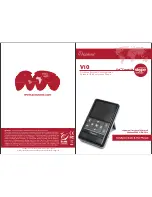
White paper
Sony Ericsson P1
54
May 2007
Symbian OS operating system
Symbian OS is the open operating system licensed
by the world's leading mobile phone
manufacturers. It is designed for the specific
requirements of advanced 2G, 2.5G and 3G mobile
phones. Symbian OS combines the power of an
integrated applications environment with mobile
telephony, bringing advanced data services to the
mass market.
Symbian OS supports a wide range of device
categories with several user interfaces, this
includes UIQ, which is the software platform used
by Sony Ericsson P1.
Key features of Symbian OS v9.1
General
• Improved system performance, especially at
start up.
• New multimedia framework supporting record-
ing, playback and streaming.
• Direct access to screen and keyboard gives
high performance, graphics accelerator API,
and increased UI flexibility (support for multiple
simultaneous display, multiple display sizes and
multiple display orientation).
• Java™ support for the latest wireless Java stan-
dards. See “Java™” on page 55 for more infor-
mation.
• Communications protocols using wide area net-
working stacks, including TCP/IP (dual mode
IPv4/v6) and IPSec. Improved personal area
networking support including infrared (IrDA),
Bluetooth™ connectivity and the introduction of
USB. Support is also provided for multihoming
and link layer Quality-of-Service (QoS) on GPRS
and UMTS networks.
• Symbian OS v9.1 is ready for the 3G market
with support for: WCDMA (3GPP R4), GSM cir-
cuit switched voice and data (CSD), packet-
based data (GPRS), SIM, and U-SIM.
• Supports the Unicode Standard version 3.0.
• Data synchronization has been improved to
cover the following: over-the-air (OTA) synchro-
nization support using OMA standards (OMADS
1.2); PC-based synchronization over, Bluetooth
connectivity, infrared and USB; a PC Connectiv-
ity suite providing the ability to transfer files and
synchronize PIM data.
• Improved device management which provides
network operators and enterprises with new
capabilities to manage phones in the field. This
includes OMA DM 1.1.2 support and OMA client
provisioning 1.1.
• Support for Bluetooth wireless technology
eSCO and Bluetooth stereo headset profiles
have been implemented.
Security
The aims of the security developments in Symbian
OS v9.1 are to protect the integrity of the phone,
provide extra control over user billable events and
to prevent malicious software corrupting
executables and data. The aims have been met by:
• Providing platform security by a proactive sys-
tem defence mechanism based on granting and
monitoring application capabilities through
Symbian Signed certification. The infrastructure
allows applications to have private protected
data stores.
• A proactive defence mechanism against mal-
ware. The platform security infrastructure uses a
capability based model which ensures that sen-
sitive operations, such as, modifying user data,
making calls and using network connections,
can only be accessed by applications which
have been certified by an appropriate signing
authority.
• Data caging, which allows applications to have
their own private data protection. This allows
applications a guaranteed secure data source.
This can be used for applications, such as,
















































